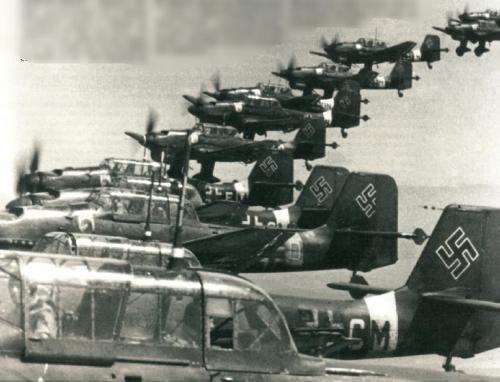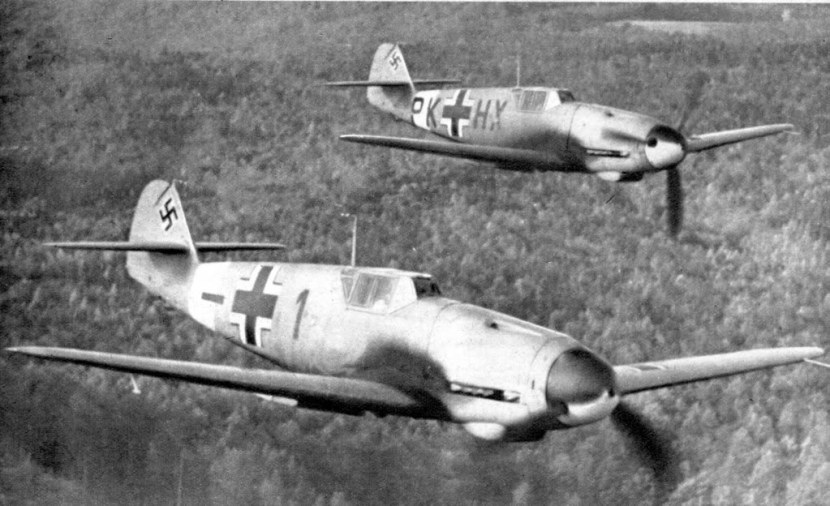

The Luftwaffe most basic fighter organization was the Rotte or section, composed of 2 aircraft: a leader (rottenführer) and a wingman (rottenflieger). The wingman flew some 200 m (600 ft.) to one side and slightly behind the leader at approximately the same altitude . The operational doctrine called for the leader to do the fighting (detect the enemy and shoot him down) while the wingman protected the vulnerable rearward sector of his leader. The fundamental principle of this type of formation consisted of welding the two fighters at all times and fighting the enemy with a 2-to-1 numerical superiority.
Historically, more than 80 percent of air-to-air victories have been achieved against an unsuspecting enemy . Therefore, the cardinal rule in air combat is to avoid being surprised. The rotte held major advantages over a single fighter. First, it was designed to assist in spotting the enemy first, the single most important advantage in combat. World War 2 day-fighters lacked in-board radar so the sole detection sensor available was the human eye . Vision has an effective range of 3.7 km (4.000 yards) when using the less sensitive peripheral vision. A 10-meter (30 ft) wide airplane can be seen as far as 18.500 meters (20.200 yards) using the fovea, but its two-degree wide cone is too narrow to detect an aircraft flying in the vast air space unless a hint of its location is given to the pilot .

This picture gives an idea of how the 2 aircraft section looked like. This image may have been taken during the Bf 109F test evaluations since the wingman shows manufacturing, rather than military identifications or it may have been a recently delivered aircraft. Under combat conditions, the separation between aircraft would be about 200 m (660 feet), considerably more than what it is shown on this picture. At 200 m the wingspan of the rear aircraft would appear to be the size of about half the horizontal stabilizer.
The wide and loose combat arrangement did not obstruct each other’s line of sight allowing both pilots to focus their attention in airspace scanning rather than in keeping close formation. Each pilot searched the front and inward sectors mostly, thus reducing the spherical search volume by 25%-35%. The decreased and more focused workload helped them to detect a foe before it reached a firing position. The vulnerable rear quarters enjoying adequate protection (see next image).
Once the engagement started, the leader required his full attention to shoot down the enemy and he was no longer in position to detect another opponent sneaking behind him. The wingman, however, by not joining the dogfight could continue devoting his attention to protect his leader’s tail. The wingman could warn his leader rapidly and the latter could then break aggressively in the direction of his attacker. If the enemy insisted on the pursuit, the rottenflieger could sandwich the enemy by a change in direction aiming at the foe’s tail .
The section provided more safety to the most experienced and valuable pilot, but it also afforded protection to the less experienced flyer who would otherwise find himself on his own. The increased protection provided by the wingman bestowed more aggressiveness to the leader enhancing his chances of a kill.
The next sized formation received the name of Schwarm or flight. It contained 2 sections flying at the same altitude, each aircraft 200 m apart from the next one for an overall 600 m width. When seen from above, the aircraft’s positions would simulate the four fingers of an outstretched hand.
The flight would approach the enemy as a unit but in combat, it would fight as two independent sections. They could provide mutual support indirectly (by their mere presence) or, if attacked, they would split in two in opposite directions, forcing the foe to pick one of them. The free section then maneuvered to position itself in the enemy’s rear.
The German bombers flew in Ketten of three aircraft rather than in a Schwarm of four, forming a V or Vic (see next image). The leader took the lead position with his wingmen to his left and right separated by a gap of one wingspan. This formation conferred mutual protection when attacked, avoided the slipstream of adjacent aircraft and permitted a compact bombing pattern.
The red air force bombers and fighters employed the Zveno (flight) of 3 aircraft flying in Vic.
SQUADRONS
The Luftwaffe’s Staffel consisted of 3 ketten of bombers (9 aircraft) or 3 Schwaerme of fighters (12 aircraft). A bomber Staffel flew approximately at the same altitude either as a Staffelkeil (previous image) or Staffelwinkel (a wedge or large Vic). Fighter schwaerme flew in line-abreast (at the same altitude or stepped up) or in line-astern (stepped up) . as can be seen in the next image. The highest flight providing top cover. This unit was led by a Hauptman with the title of Staffelkapitaen.
The Eskadrilya composed of 12 bombers (4 Zvena) or 15 fighters (5 Zvena) was the VVS equivalent formation .
WINGS
A fighter Gruppe or wing was composed of 3 Staffeln and a Stabsschwarm for a total of 40 aircraft. In the case of bombers, the 3 Staffeln and the Stabskette totaled 30 aircraft. The Gruppe would have its airfield and it was the largest tactical formation employed by the German fighters in combat at this period of the war. The Gruppe’s component Staffeln flew stepped up in line astern typically. This unit was commanded by a Gruppenkommandeur that usually had the rank of a Major. There were only a few dozen Gruppenkommandeure in the Luftwaffe as a whole and these individuals were carefully selected based on their merit in combat, leadership, training, and combat experience. The equivalent VVS formation was the Polk (regiment) comprising 62 aircraft. The fighter Polk comprised 4 Eskadril’i while the bomber Polk had 5. Every Polk included one staff flight of 2 planes as well. Each Polk occupied one airfield .
GESCHWADER AND DIVIZIYA
The largest homogeneous tactical formation that the Germans employed was the Geschwader.
Composed of 3 Gruppen plus a Stabsschwarm. Starting with the Battle of Britain, bombers frequently fought at full Geschwader strength to maximize protection but for the most part, they did so at Gruppe strength. Fighters at this stage of the war fought at Gruppe strength or below. Reconnaissance aircraft carried their missions singly.
A Geschwader was commanded by an Oberstleutnant or Oberst (Coronel) with the title of Geschwaderkommodore.
There were several types of Geschwader, the most common were:
- Jagdgeschwader (JG) = fighters
- Zerstoerergeschwader (ZG) = heavy fighters
- Kampfgeschwader (KG) = bombers
- Sturzkampfgeschwader (St.G) = dive bombers
- Lehrgeschwader (LG) = tactical development unit (who develop suitable tactics)
There were also transportation Geschwader (KG. zb V) and reconnaissance Gruppen (Aufklärungsgruppe).
The VVS Aviatsionnaya Diviziya (Division) numbered 2 to 5 Polki. These divisions were formed with solely a fighter component (IAD or Istrebitelyenaya Aviatsionnaya Diviziya), solely bombers (two types: BAD or Bombardirovochnaya Aviatsionnaya Diviziya and SBAD or Skorostnaya Bombardirovochnaya Aviatsionnaya Diviziya -high-speed bomber division-), solely ground attack aircraft (ShAD or Shturmovaya Aviatsionnaya Diviziya) or mixed divisions (SAD or Smeshannaya Aviatsionnaya Diviziya) which combined fighter, bomber, and/or ground attack regiments. There were also reconnaissance regiments (RAP or Razvedyvatelnyye Aviatsionnaya Polki).